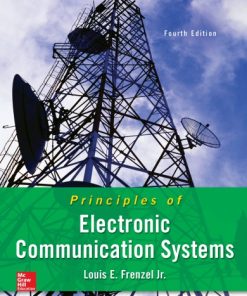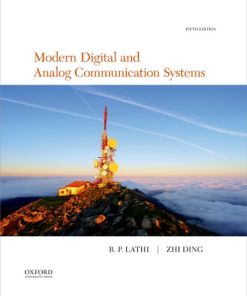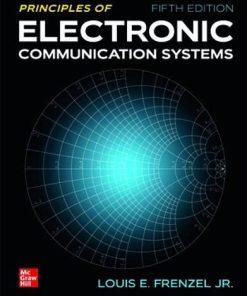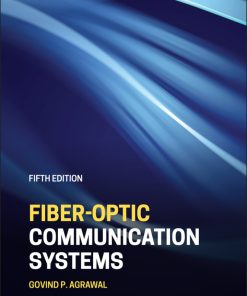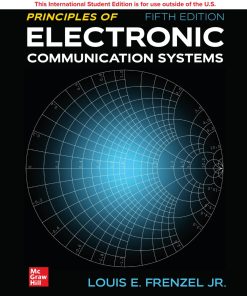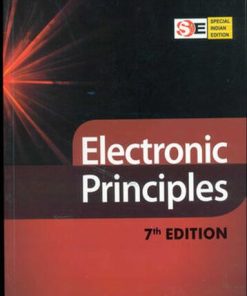(Ebook PDF) Principles of Electronic Communication Systems 5th Edition by Louis Frenzel 1260789365 9781260789362 full chapters
$50.00 Original price was: $50.00.$25.00Current price is: $25.00.
Principles of Electronic Communication Systems 5th Edition by Louis Frenzel 1260789365 9781260789362 – Ebook PDF Instant Download/DeliveryISBN: 1260789365 9781260789362
Full dowload Principles of Electronic Communication Systems 5th Edition after payment.

Product details:
ISBN-10 : 1260789365
ISBN-13 : 9781260789362
Author: Louis Frenzel
Principles of Electronic Communication Systems provides the most up-to-date survey available for students taking a first course in electronic communications. Requiring only basic algebra and trigonometry this new edition is notable for its readability learning features and numerous full-color photos and illustrations. A systems approach is used to cover state-of-the-art communications technologies to best reflect current industry practice.This title is available in Connect with SmartBook featuring end-of-chapter homework problems and auto-graded questions from the manual. Instructor Resources for this title include an Instructor’s Manual and Lab and Experiments Manual Answers.
Principles of Electronic Communication Systems 5th Table of contents:
Chapter 1 Introduction to Electronic Communication 1
1-1 The Significance of Human Communication 3
1-2 Communication Systems 3
1-3 Types of Electronic Communication 5
1-4 Modulation and Multiplexing 8
1-5 The Electromagnetic Spectrum 12
1-6 Bandwidth 18
1-7 A Survey of Communication Applications 21
1-8 Jobs and Careers in the Communication Industry 23
Chapter 2 Electronic Fundamentals for Communications 31
2-1 Gain, Attenuation, and Decibels 32
2-2 Tuned Circuits 42
2-3 Filters 57
2-4 Fourier Theory 79
Chapter 3 Amplitude Modulation Fundamentals 94
3-1 AM Concepts 95
3-2 Modulation Index and Percentage of Modulation 97
3-3 Sidebands and the Frequency Domain 100
3-4 AM Power 106
3-5 Single-Sideband Modulation 110
3-6 Current AM/ASK Radio Usage 114
3-7 Classification of Radio Emissions 115
Chapter 4 Amplitude Modulator and Demodulator Circuits 119
4-1 Basic Principles of Amplitude Modulation 120
4-2 Amplitude Modulators 123
4-3 Amplitude Demodulators 131
4-4 Balanced Modulators 138
4-5 SSB Circuits 143
Chapter 5 Fundamentals of Frequency Modulation 150
5-1 Basic Principles of Frequency Modulation 151
5-2 Principles of Phase Modulation 153
5-3 Modulation Index and Sidebands 156
5-4 Noise Suppression Effects of FM 165
5-5 Frequency Modulation Versus Amplitude Modulation 169
Chapter 6 FM Circuits 174
6-1 Frequency Modulators 175
6-2 Phase Modulators 181
6-3 Frequency Demodulators 184
6-4 FSK Circuits 188
Chapter 7 Digital Communication Techniques 194
7-1 Digital Transmission of Data 195
7-2 Parallel and Serial Transmission 196
7-3 Data Conversion 199
7-4 Pulse Modulation 224
7-5 Digital Signal Processing 228
Chapter 8 Radio Transmitters 237
8-1 Transmitter Fundamentals 238
8-2 Carrier Generators 242
8-3 Power Amplifiers 260
8-4 Impedance-Matching Networks 278
8-5 Typical Transmitter Circuits 287
Chapter 9 Communication Receivers 291
9-1 Basic Principles of Signal Reproduction 292
9-2 Superheterodyne Receivers 295
9-3 Frequency Conversion 297
9-4 Intermediate Frequency and Images 306
9-5 Noise 311
9-6 Typical Receiver Circuits 323
9-7 Typical Receivers and Transceivers 332
Chapter 10 Digital Data Transmission 340
10-1 Digital Codes 341
10-2 Principles of Digital Transmission 343
10-3 Transmission Efficiency 350
10-4 Modem Concepts and Methods 355
10-5 Wideband Modulation 370
10-6 Broadband Modem Techniques 379
10-7 Error Detection and Correction 383
10-8 Protocols 393
Chapter 11 Multiplexing, Duplexing, and Multiple Access 401
11-1 Multiplexing Principles 402
11-2 Frequency-Division Multiplexing 403
11-3 Time-Division Multiplexing 408
11-4 Pulse-Code Modulation 415
11-5 Multiple Access 421
11-6 Duplexing 424
Chapter 12 Digital and Software-Defined Radios 428
12-1 Defining the Digital and Software-Defined Radios 429
12-2 Making SDR Possible 430
12-3 Replacing Analog Functions with Digital Processes 431
12-4 The Benefits of SDRs 431
12-5 Software-Defined Radio: Receivers 432
12-6 Software-Defined Radio: Transmitters 434
12-7 A Survey of Software-Defined Radios 435
12-8 Cognitive Radios 442
Chapter 13 Transmission Lines 445
13-1 Transmission Line Basics 446
13-2 Standing Waves 459
13-3 Transmission Lines as Circuit Elements 468
13-4 The Smith Chart 473
Chapter 14 Fundamentals of Networking, Local-Area Networks, and Ethernet 486
14-1 Network Fundamentals 487
14-2 LAN Hardware 495
14-3 Ethernet LANs 502
14-4 Advanced Ethernet 511
14-5 Special Ethernet Variations 513
Chapter 15 Wired Data Communications 518
15-1 Rationale for Serial I/O 519
15-2 Serial I/O Applications 520
15-3 Low-Speed Serial Interfaces 521
15-4 High-Speed Serial Interfaces 526
Chapter 16 Antennas and Wave Propagation 530
16-1 Antenna Fundamentals 531
16-2 Common Antenna Types 539
16-3 Radio Wave Propagation 562
Chapter 17 Internet Technologies 580
17-1 Internet Applications 581
17-2 Internet Transmission Systems 583
17-3 Cloud Networking and Virtual Systems 599
17-4 Storage-Area Networks 601
17-5 Internet Security 604
17-6 Internet Telephony 609
Chapter 18 Microwave and Millimeter-Wave Communication 614
18-1 Microwave Concepts 615
18-2 Microwave Transmission Lines and Devices 622
18-3 Waveguides and Cavity Resonators 632
18-4 Microwave Semiconductor Diodes 641
18-5 Microwave Tubes 644
18-6 Microwave Antennas 648
18-7 Microwave and Millimeter-Wave Applications 668
Chapter 19 Satellite Communication 681
19-1 Satellite Orbits 682
19-2 Satellite Communication Systems 689
19-3 Satellite Subsystems 693
19-4 Ground Stations 698
19-5 Satellite Applications 702
19-6 Global Navigation Satellite Systems 707
Chapter 20 Optical Communication 718
20-1 Optical Principles 719
20-2 Optical Communication Systems 723
20-3 Fiber-Optic Cables 728
20-4 Optical Transmitters and Receivers 740
20-5 Wavelength-Division Multiplexing 755
20-6 Passive Optical Networks 757
20-7 400-Gbps Networks and Beyond 760
Chapter 21 Cell Phone Technologies 769
21-1 Cellular Telephone Systems 770
21-2 A Cellular Industry Overview 772
21-3 2G and 3G Digital Cell Phone Systems 774
21-4 Long-Term Evolution and 4G Cellular Systems 776
21-5 Fifth-Generation Wireless Cellular 784
21-6 Smartphone Analysis 786
21-7 Base Stations and Small Cells 789
Chapter 22 Wireless Technologies 800
22-1 Wireless LAN 801
22-2 Bluetooth 808
22-3 ZigBee and Mesh Wireless Networks 810
22-4 Radio-Frequency Identification and Near-Field Communications 813
22-5 Ultrawideband Wireless 817
22-6 Optional Wireless Technologies 820
22-7 Internet of Things 823
Chapter 23 Communication Tests and Measurements 829
23-1 Communication Test Equipment 830
23-2 Common Communication Tests 849
23-3 Troubleshooting Techniques 867
23-4 Electromagnetic Interference Testing 871
People also search for Principles of Electronic Communication Systems 5th:
principles of electronic communication systems ppt
principles of electronic communication systems 3rd edition
principles of electronic communication systems third edition
principles of electronic communication systems by frenzel 3rd edition
principles of electronic communication systems chapter 1
You may also like…
Engineering - Electrical & Electronic Engineering
Engineering - Telecommunications
Engineering - Telecommunications
Modern Digital and Analog Communication Systems 5th Edition B. P. Lathi
Technique - Electronics: Fiber Optics
Engineering - Electrical & Electronic Engineering
Principles of Electronic Communication Systems 5th Edition by Louis Frenzel 1260789365 9781260789362
Technique - Electronics
Engineering - Electrical & Electronic Engineering




